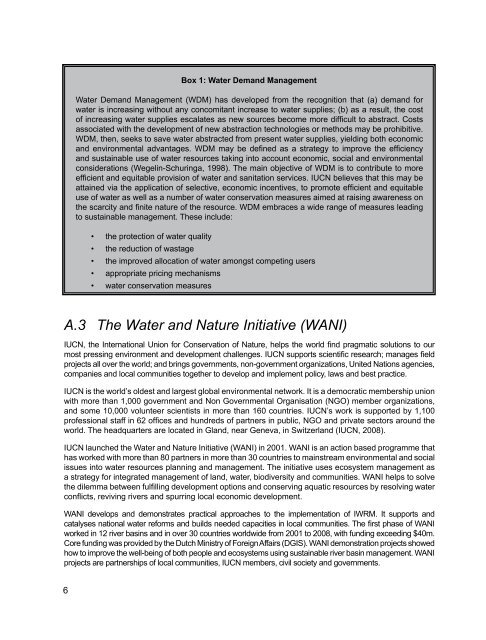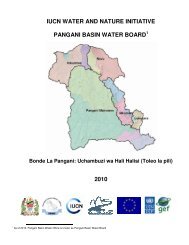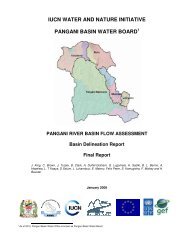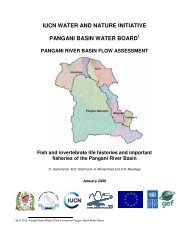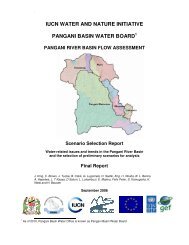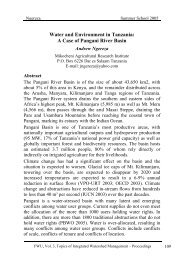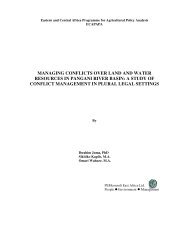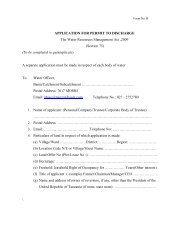PANGANI BASIN WATER BOARD
PANGANI BASIN WATER BOARD
PANGANI BASIN WATER BOARD
You also want an ePaper? Increase the reach of your titles
YUMPU automatically turns print PDFs into web optimized ePapers that Google loves.
Box 1: Water Demand Management<br />
Water Demand Management (WDM) has developed from the recognition that (a) demand for<br />
water is increasing without any concomitant increase to water supplies; (b) as a result, the cost<br />
of increasing water supplies escalates as new sources become more difficult to abstract. Costs<br />
associated with the development of new abstraction technologies or methods may be prohibitive.<br />
WDM, then, seeks to save water abstracted from present water supplies, yielding both economic<br />
and environmental advantages. WDM may be defined as a strategy to improve the efficiency<br />
and sustainable use of water resources taking into account economic, social and environmental<br />
considerations (Wegelin-Schuringa, 1998). The main objective of WDM is to contribute to more<br />
efficient and equitable provision of water and sanitation services. IUCN believes that this may be<br />
attained via the application of selective, economic incentives, to promote efficient and equitable<br />
use of water as well as a number of water conservation measures aimed at raising awareness on<br />
the scarcity and finite nature of the resource. WDM embraces a wide range of measures leading<br />
to sustainable management. These include:<br />
• the protection of water quality<br />
• the reduction of wastage<br />
• the improved allocation of water amongst competing users<br />
• appropriate pricing mechanisms<br />
• water conservation measures<br />
A.3 The Water and Nature Initiative (WANI)<br />
IUCN, the International Union for Conservation of Nature, helps the world find pragmatic solutions to our<br />
most pressing environment and development challenges. IUCN supports scientific research; manages field<br />
projects all over the world; and brings governments, non-government organizations, United Nations agencies,<br />
companies and local communities together to develop and implement policy, laws and best practice.<br />
IUCN is the world’s oldest and largest global environmental network. It is a democratic membership union<br />
with more than 1,000 government and Non Governmental Organisation (NGO) member organizations,<br />
and some 10,000 volunteer scientists in more than 160 countries. IUCN’s work is supported by 1,100<br />
professional staff in 62 offices and hundreds of partners in public, NGO and private sectors around the<br />
world. The headquarters are located in Gland, near Geneva, in Switzerland (IUCN, 2008).<br />
IUCN launched the Water and Nature Initiative (WANI) in 2001. WANI is an action based programme that<br />
has worked with more than 80 partners in more than 30 countries to mainstream environmental and social<br />
issues into water resources planning and management. The initiative uses ecosystem management as<br />
a strategy for integrated management of land, water, biodiversity and communities. WANI helps to solve<br />
the dilemma between fulfilling development options and conserving aquatic resources by resolving water<br />
conflicts, reviving rivers and spurring local economic development.<br />
WANI develops and demonstrates practical approaches to the implementation of IWRM. It supports and<br />
catalyses national water reforms and builds needed capacities in local communities. The first phase of WANI<br />
worked in 12 river basins and in over 30 countries worldwide from 2001 to 2008, with funding exceeding $40m.<br />
Core funding was provided by the Dutch Ministry of Foreign Affairs (DGIS). WANI demonstration projects showed<br />
how to improve the well-being of both people and ecosystems using sustainable river basin management. WANI<br />
projects are partnerships of local communities, IUCN members, civil society and governments.<br />
6


